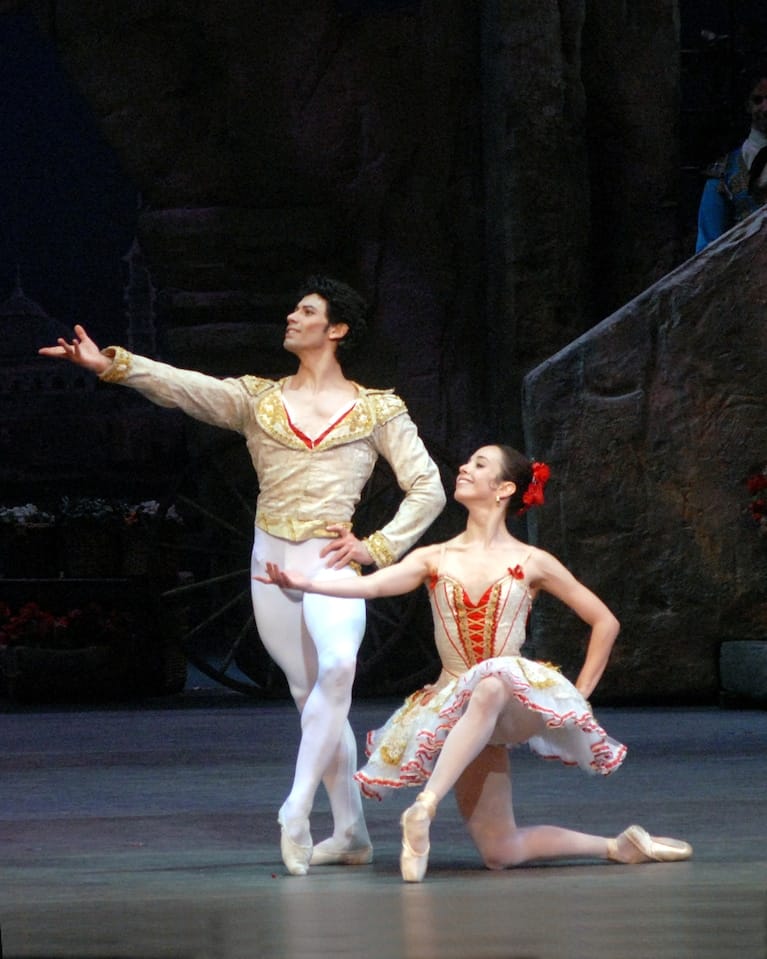Fiesta Time

"Don Quixote"
American Ballet Theatre
Metropolitan Opera House
New York, NY
June 11, 2008, Matinee
This vibrant, detailed, and exciting performance of the Petipa-based Spanish comedy remotely connected to Cervantes featured, among other joys, the debut of Herman Cornejo as the poor barber Basilio. The artistic gods aren't known for their fairness, and his comparatively short stature and Puckish looks make the more extravagantly noble ballet heroes a stretch, but his exceptional technique and distinctive personality make him a natural for leading roles. He danced Basilio like a human gyroscope on springs, but he also made Basilio warm, tender, and playful. As yet, he doesn't project the calm nobility in the third act of some more naturally elegant dancers, worshiping their Kitris as she twirls away, but he didn't just stand there waiting for his chance; this was more of a friendly conversation.
He was talking to Xiomara Reyes, whose natural stage presence and piquant sense of comedy made this a very human story. She was best as the flirtatious, charming Kitri of the first act. She didn't quite develop the contrast between the earthy first act-dancer, the ethereal vision, and the grand classical ballerina that Petipa challenges his dancers to create; she is more of a soubrette, and her Kitri was warmly human throughout. One the fouette front, though, she did seem more than human, using the bright red fan held high to signal her many, very secure, doubles. A technical tour de force, well-deserving of the raucous cheers, but she also made them seem fun.
But if "Don Quixote" were only spins and jumps and the final pas de deux, I doubt if it would have lasted as well as it has. It also has its acting and artistic challenges, in the character of the hapless suitor Gamache and the vestigial Don, and one of the wonderful vision scenes. The deluded Don was Victor Barbee, who made the opening scene, where he sees the vision of the unattainable Dulcinea, into a moving little vignette, a mini-portrait of everyone who trys to reach for beauty. Gamache, so long the province of the remarkable and much missed Guillaume Graffin, was danced (acted is too limited a word) by the young Craig Salstein, in an astoundingly detailed and often subtle comic turn. He was the epitome of prissy manners and mincing pride, pulling out his sword at any and every perceived slight to his delicate honor. I'm afraid that I missed much of Kristi Boone's languorous Mercedes, because I couldn't help but watch Salstein time the most obvious pratfalls.
The vision scene, though it doesn't have the dramatic power of the white act of "La Bayadere", or the poetry of "The Sleeping Beauty's" (when done right), or the musical richness of the "Jardin Anime" scene, has its own gentle power, and it is pure bliss. It was dominated by Melissa Thomas' radiant and scrupulous Queen of the Dryads, and Anne Milewski's charming Amour. This seems, to judge from the various Russian versions I have seen, to be a fairly unobstructed view of what passes as the original choreography; the same can't be said, though, for the so-called gypsy camp dances. These look like a combination of Hollywood Red Indians, the Polovotsian tribes, and a rumble from West Side Story; Misty Copeland as Anita and Joseph Phillips as Bernardo (here called the Gypsy couple) were a feisty handfull. But the performance ultimately belonged to Cornejo; may there be many more to come.
copyright © 2008 by Mary Cargill



